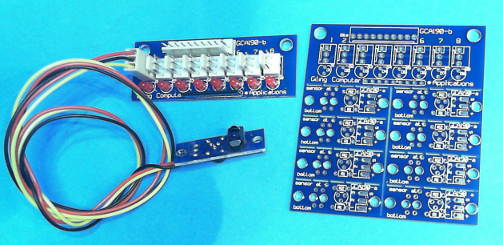Table of Contents
GCA190 Infra red reflector gate for mounting between sleepers.
Description
In the modeltrain world we have various different ways of generating contacts, so called feed-back.
They are absolutely indispensable in automatic control.
In general, I mention here 8 different ways, but there are more, mostly more expensive:
- 1. Railcontact, where the train makes a short circuit between the rails. Very common with everything from Göppingen,
- 2. Current detection, a system where a part of the track is isolated and any current drawn from that isolated section generates a contact. GCA offers GCA93 and/or GCA94 for it.
- 3. MFX and Railcom and Lissy, sending back their decoder address, but the exact location has to be added separately.
- 4. Reedcontacts and hall sensors, needing a magnet under your riding material. GCA offers the GCA173 (GCA179) for that option.
- 5. GCA173 can also be used together with GCA173i, to use it as reflection Infra-rad sensors.
- 6. GCA173, with adapted firmware, can als be used with GCA173 wheel-counter. Rocrail is also adapted to this.
- 7. Infra red gates or reflectors. GCA has the GCA133 and GCA141(LocoNet) in program to achieve that
- 8. RFID, a system where a transponder is fixed to the rolling stock.
- 9. Many other, ususally more expensive, systems.
- 10. GCA190, IR detection for feed-back of your trains always seemed to be either hard, or complicated.
It is rather easy to install, and no cutting in the tracks is needed.
The used sensor is a TCRT5000, and is not sensitive for normal (day)light.
Consider this: A TL lamp straight above sensor on a distance of 1,5 m is too much light.
In those cases, fit the sensor with an angle so the light does not radiate in directly.
The way the systems works is not suitable for wheel (-magnet) counting because it reacts on almost anything that approaches within 15 mm distance
To get a very good signal, some black plastic wagons might need a bit of white paint on the bottom,
but anything metal will be detected 100%, even the axes of the wheels.
The benefit of this unit is a reliable and simple way of installation.
The unit comes as a set with 8 sensor boards and an connection/indication board, with the standard
interface connection, which adapts GCA50(0)(a)(LocoNet), CAN-GC2(CBUS), RocNet (Raspberry Pi) and WIO.
It also can be used for connection with S88 modules, but then 5V should be added for supply. Ask Peter.
With all 8 sensors connected, the board needs 65 mA at 5V supply.
When sensors are 'active', the current will increase by 4 mA for each sensor.
The sensor itself fits nicely on the solder-side but can be connected with wires to it, if needed.
TCRT5000 sensor is also available as a type with longer wires (TCRT5000L).
The size of it is 5,5x10mm, and could be mounted sideways along a track, where it will react on passing wheels, or fits between the sleepers.
The first look into the technical description showed that the sensor needs quite some current : 60 mA.
That was not acceptable, since an octal set of these sensors like this GCA190, would draw almost 0.5Amp !!
The TCRT5000 could easily be used without any pc-board, but because of this power consumption, a board was
indispensable with the extra Fet Transistor and two resistors.
That made it possible to reduce the power consumption dramatically.
All together, the board remains small, and will fit nicely under the track.
How it looks like
How to fix the sensor board.
The idea for this sensor came from the wish to use it for tramway and Faller-car system.
In tramway situation, cutting rails, after finishing the scenery, is difficult, because of the way rails are fixed in the tarmac.
Now, if a sensor is 'misplaced', it is very easy easy to make a hole somewhere else and put the sensor there.
The sensor board could be fixed under the bottom of the baseboard with little screws, but an easier way is using hot glue.
Fixing is easy and also removing , when ever necessary, is also quite simple.
The same remarks count for using the sensor in Faller-car system.
Different options
1)The sensors as used in the GCA190 board are working fine when the sensor is not exposed to much light.
There is also an option for a different sensor board, which can also be used in normal lighted area.
This sensor is mounted on a small board , GCA173i, which has an Infrared transiever on board and a separate IR led.
The led can be placedd opposite the transceiver ( where a train runs through the beam and braks the Infrared light beam.
Put the led along the transceiver and you will have a signal when the Infrared beam is reflected.
2)There is also a small board GCA94-s available which will be published in short time.
This unit is 1/8 of the GCA94, which is sensing currents that can be as low as coming from an N-track train, to any large scale, like G or 1,
and also provides a 100% isolation with anything, achieved by the use of a current transformer coil.

